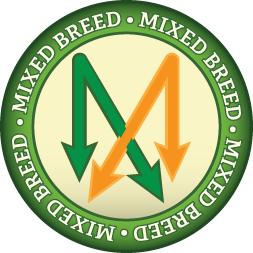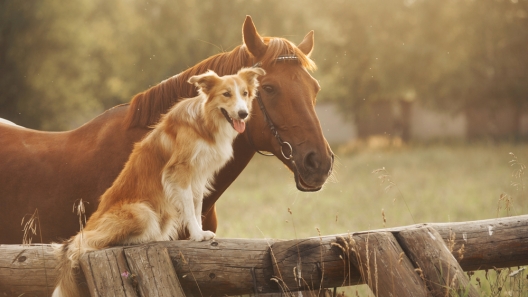
-
Activity Level:
high
-
Shedding Level:
moderate
-
Grooming Level:
low
-
Trainability:
high
-
Good for Novice Owners:
moderate
-
Adaptability:
moderate
-
Kid/Pet Friendly:
often
-
Prey Drive:
high
-
Watchdog:
very alert
- Average Size: Medium
- Average Lifespan: 12-16 years
Blue Heeler Mix Dog Breed Information
Overview
Temperament
Adaptability
Health
Owner Experience
Grooming
Activity Level
Size
Life Span
A Blue Heeler Mix is a cross between a Blue Heeler and another dog breed. A Blue Heeler is an energetic working dog that loves their family. You should be able to expect something similar from a Blue Heeler Mix. But, because a mixed-breed dog can inherit any combination of characteristics from their parent breeds, it’s important to ask the breeder about the other parent breed.
A Blue Heeler is an affectionate dog that is loyal and devoted to their families. They tend to get along with children and even other pets in the family despite their high prey drive. They also tend to be protective of anyone they consider family and are naturally wary of strangers.
The other parent breed could introduce some other characteristics that affect potential temperament in a Blue Heeler Mix. So, you do want to make sure you ask the breeder about the other parent breed in the mix. You can also meet the mother dog to see what sort of temperament she has and the behavior she is modeling for her puppies.
Because a Blue Heeler Mix is likely to have a protective instinct like their Blue Heeler parent, it is especially important to socialize them early and often and train them well. The breeder should be socializing the puppies in their care, but socialization is an ongoing process so it is up to you to continue socializing a puppy once you get them home.
The Blue Heeler is a moderately adaptable dog. Because they are a high-energy working dog, they don’t tend to do well in apartments and tend to thrive in homes with fenced yards. They do tend to be hardy dogs that thrive in most climates and can handle some alone time.
As long as the other parent breed has similar traits, you should be able to expect similar adaptability from a Blue Heeler Mix. It’s a good idea to talk to the breeder about the other parent breed in the mix so you have a better idea of what potential adaptability to expect.
Are mixed-breed dogs healthier than purebred dogs? They can be sometimes, but it’s not a guarantee. Although a mixed-breed dog can sometimes “win the genetic lottery” and inherit none of the potential health concerns common to their parent breeds, they can actually inherit any combination from one, both, or neither of them.
From the Blue Heeler side, potential health concerns can include deafness, hip dysplasia, elbow dysplasia, and progressive retinal atrophy. Being born deaf is more common in the Blue Heeler than other dog breeds, but it is not known to negatively affect their quality of life.
Reputable breeders will screen their dogs to avoid passing issues on to puppies. So, make sure you ask the breeder about the health and genetic history of both of the parent breeds. This can help allay any potential health concerns you may have with a Blue Heeler Mix puppy.
Blue Heelers are high-energy and hardworking dogs. Although they are intelligent and pick up on things quickly, which makes them easy to train, they do get bored easily and require a job to do to be happy. This can be a challenge for first-time dog owners.
The other parent breed may introduce traits that could make a Blue Heeler Mix more or less difficult to train. You want to ask the breeder about them so you know what potential range of trainability to expect and you also want to be prepared to enroll in puppy training classes.
Regardless of your experience with dogs, puppy training classes still tend to be a great idea because they often offer a lot of opportunities for socialization in addition to strengthening the bond you have with your puppy.
Because a mixed-breed dog could inherit a coat similar to either of their parents or a combination from them, you want to make sure you ask the breeder about the other parent breed. Should a Blue Heeler Mix inherit the Blue Heeler coat, it will be short, shed moderately year-round, and shed more heavily as the seasons change. Weekly brushing, daily brushing during seasonal shedding, and an occasional bath as needed are enough for this coat.
Regardless of coat type, you will also need to care for your Blue Heeler Mix’s nails, ears, and teeth. Cutting your dog’s nails monthly is usually enough to keep them from growing too long. Checking ears weekly and carefully cleaning your dog’s ears as needed can help prevent ear infections. Brushing teeth or using an enzyme toothpaste every day is ideal dental care for dogs and can help prevent painful dental diseases later in life.
The Blue Heeler is a high-energy working dog that requires a lot of daily exercise and a job to do to be happy and healthy. Daily walks plus time playtime and time to run is usually enough for this dog, but they will likely always be up for more activity if you are.
If the other parent breed is also high-energy, then you can expect the same from a Blue Heeler Mix. If the other parent breed is a lower energy dog, a Blue Heeler Mix could also be lower energy. But, you still want to be prepared for the potential of a high-energy dog breed.
A fully-grown Blue Heeler usually stands 17-20 inches tall and weighs 30-50 pounds. The other parent breed could affect this, so you want to make sure you ask the breeder about them and pay attention to which breed is the mother. Although it is not a guarantee, you can also meet the mother dog in-person to get an idea of what size to expect in a Blue Heeler Mix.
Blue Heelers generally live for 12-16 years. Although the other parent breed could affect this slightly, you should be able to expect a similar life span in a Blue Heeler Mix.









